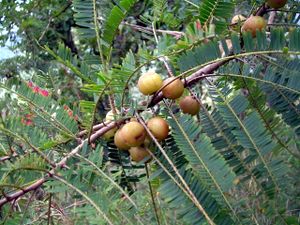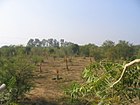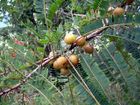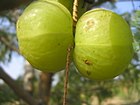Note: This is a project under development. The articles on this wiki are just being initiated and broadly incomplete. You can Help creating new pages.
Phyllanthus emblica - Triphala
Amalaki is an Ayurvedic herbal rasayana formula consisting of equal parts of three myrobalans taken without seed.
Uses
Diabetes, Jaundice, Stomachache, Gynaecological disorder, Cough, Mouth ulcer, Heart problems, Diarrhea, Asthma, Cold, Acidity
Parts Used
Chemical Composition
Triacontanol (1), Triacontanoic acid (2), β-Amyrin ke- tone (3), Betulonic acid (4), Daucosterol (5), Lupeol acetate (6), β-Amyrin-3-palmitate (7), Gallic acid (8), Betulinic acid (9), Ursolic acid (10), Oleanolic acid (11), Quercetin (12) and Rutin (13)[1]
Common names
| Language | Common name |
|---|---|
| Kannada | Betta Nelli |
| Hindi | Aonla, Amla |
| Malayalam | Nellikka, Amalakam |
| Tamil | Konkam |
| Telugu | Amalakamu |
| Marathi | NA |
| Gujarathi | NA |
| Punjabi | NA |
| Kashmiri | NA |
| Sanskrit | Amalakah |
| English | Indian Gooseberry |
Properties
Reference: Dravya - Substance, Rasa - Taste, Guna - Qualities, Veerya - Potency, Vipaka - Post-digesion effect, Karma - Pharmacological activity, Prabhava - Therepeutics.
Dravya
Rasa
Tikta (Bitter), Kashaya (Astringent)
Guna
Laghu (Light), Ruksha (Dry), Tikshna (Sharp)
Veerya
Ushna (Hot)
Vipaka
Katu (Pungent)
Karma
Kapha, Vata
Prabhava
Habit
Identification
Leaf
| Kind | Shape | Feature |
|---|---|---|
| Simple | Alternate | Bark light grey and exfoliating. Leaf feathery, smaller towareds the apex and the base, tip reddish |
Flower
| Type | Size | Color and composition | Stamen | More information |
|---|---|---|---|---|
| Unisexual | 2-4cm long | reddish | 5 | Flowering from March-April |
Fruit
| Type | Size | Mass | Appearance | Seeds | More information |
|---|---|---|---|---|---|
| 7–10 mm (0.28–0.4 in.) long pome | Fruiting May onwards | A depressed-globose drupe | many | {{{6}}} |
Other features
List of Ayurvedic medicine in which the herb is used
- Vishatinduka Taila as root juice extract
Where to get the saplings
Mode of Propagation
How to plant/cultivate
A plant mainly of the hot, tropical lowlands, succeeding in both humid and semi-arid areas[3]
Commonly seen growing in areas
Photo Gallery
References
External Links
- Ayurvedic Herbs known to be helpful to treat Diabetes
- Ayurvedic Herbs known to be helpful to treat Jaundice
- Ayurvedic Herbs known to be helpful to treat Stomachache
- Ayurvedic Herbs known to be helpful to treat Gynaecological disorder
- Ayurvedic Herbs known to be helpful to treat Cough
- Ayurvedic Herbs known to be helpful to treat Mouth ulcer
- Ayurvedic Herbs known to be helpful to treat Heart problems
- Ayurvedic Herbs known to be helpful to treat Diarrhea
- Ayurvedic Herbs known to be helpful to treat Asthma
- Ayurvedic Herbs known to be helpful to treat Cold
- Ayurvedic Herbs known to be helpful to treat Acidity
- Herbs with leaves used in medicine
- Herbs with fruit used in medicine
- Herbs with common name in Kannada
- Herbs with common name in Hindi
- Herbs with common name in Malayalam
- Herbs with common name in Tamil
- Herbs with common name in Telugu
- Herbs with common name in Sanskrit
- Herbs with common name in English
- Habit - Herb
- Index of Plants which can be propagated by Seeds
- Index of Plants which can be propagated by Cuttings
- Herbs that are commonly seen in the region of Mixed forests
- Herbs that are commonly seen in the region of Drier forests
- Herbs that are commonly seen in the region of Dry open sparse forests or scrub
- Herbs
- Ayurvedic herbs that don't have flower, fruit and leaf photos
- Ayurvedic herbs that don't have seed photos





